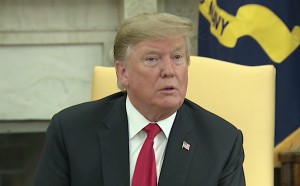
The Trump administration agreed to lift the steel and aluminum tariffs on Mexico and Canada in order to keep out Chinese steel.
Seeking to secure Congressional approval of the U.S.-Mexico-Canada trade deal, or USMCA, U.S. negotiators secured tough new measures against Chinese steel by agreeing to lift tariffs on steel and aluminum from Mexico and China.
The deal avoids quotas on steel from the two countries, which Canada and Mexico had opposed, according to the Washington Post. The tariffs will end in 48 hours.
“We came to an agreement that benefits both parties: the tariffs are lifted, without quotas on steel and aluminum,” according to a statement from the Mexican president’s office, adding that it reinstated a tariff-free commercial relationship for those products.
The news of the change was welcomed by at least one automaker.
(Tariff talk put on hold for six months by Trump administration. Click Here for the story.)
“We are pleased that the U.S., Canada and Mexico have reached an agreement that will help us a region to be more competitive,” Joe Hinrichs, Ford president, Automotive, told TheDetroitBureau.com.
Negotiators for the Trump administration had been working to finalize the trade agreement to replace the North American Free Trade Agreement, or NAFTA, after getting a preliminary approval from the president.
However, some members of Congress weren’t entirely thrilled with components of the deal, and ultimately all trade agreements between the U.S. and other countries must be approved by both houses of Congress.
The Trump team is also in the midst of intense negotiations with China, which appeared to be going well until recently. The U.S. team accused China of going back on all of the tenets of the deal it had agreed to that point and walked away from talks.
(Click Here to see Toyota’s CEO say he’s “sad” about being considered a security threat.)
The two sides agreed to return to the table, but in the meantime Trump instituted a 25% tariff on more than $300 billion in goods from the country. China retaliated by raising tariffs on more than $60 billion in products from the U.S.
All of this is complicated by the recent findings by the U.S. Secretary of Commerce Wilbur Ross, who’s team concluded that imported automobiles and automotive parts could be considered threats to national security. Under Section 232 of the Trade Expansion Act of 1962, Trump could then place tariffs on those items. He had until May 18 to make a decision about it.
He elected to put off any decision for six months, which is allowed under the law; however, Trump took a swipe at the European Union today suggesting its members treated the U.S. worse than China does as a trade partner.
“The European Union treats us, I would say, worse than China, they’re just smaller,” Trump told a gathering of real estate agents in Washington, Reuters reported.
(China suspends punitive tariffs during trade negotiations. Click Here for the story.)
Trump directed U.S. Trade Representative Robert Lighthizer to pursue negotiations with the EU, Japan and any other country he deemed appropriate and report back within 180 days. If no deal is reached, Trump will decide by then “whether and what further action needs to be taken.”
